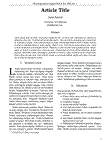Resultados de búsqueda - ((niza OR ((alfa OR all) OR alta)) OR (((meliza OR elisa) OR evita) OR ((anna OR daena) OR lanza)))
Materias dentro de su búsqueda.
Materias dentro de su búsqueda.
- 12
- México 10
- educación 9
- innovación 8
- education 6
- Derechos Humanos 5
- I23 5
- Innovación 5
- Mediation 5
- Mexico 5
- Motivación 5
- educación superior 5
- estudiantes 5
- human rights 5
- organización 5
- political communication 5
- shrimp 5
- Covid-19 4
- Economía 4
- Educación 4
- I21 4
- Inclusión 4
- M10 4
- Mediación 4
- Nuevo León 4
- comunicación política 4
- democracia 4
- enseñanza 4
- estrategia 4
- innovation 4
-
41
-
42
-
43
-
44
-
45
-
46
Historia de la Revolución de México contra la Dictadura del General Santa-Anna, 1853-1855.
Publicado 2015Materias: “…Santa Anna, Antonio López de, 1794-1876…”
Enlace del recurso
-
47
-
48
Concretos sustentables expuestos a altas temperaturas
Publicado 2016“…Se curaron a 20ºC y 100% de humedad hasta 7 años y después fueron expuestos a altas temperaturas (350°C, 550°C y 750°C). Se les evaluó la velocidad de ultrasonidos (UPV), análisis termogravimétrico/diferencial (TG/DTA), difracción de rayos X (DRX) y microscopía electrónica de barrido (MEB). …”
Enlace del recurso
Artículo -
49
-
50
-
51
LAS ALTAS CULTURAS PRECOLOMBINAS DE MESOAMÉRICA
Publicado 2021“…AMÉRICA PRECOLOMBINA, en cuanto al desarrollo de sus altas culturas, ofrece dos centros culturales bien diferentes, uno más al Norte y otro más al Sur, sin que ninguno de ellos se sitúe hacia los extremos septentrional y meridional del continente. …”
Enlace del recurso
Artículo -
52
A new species of Perinereis (Polychaeta, Nereididae) from Florida, USA, with a key to all Perinereis from the American continent
Publicado 2013“…The new species resembles P. singaporiensis based on the absence of notopodial prechaetal lobe; however, the two species differ in some morphological characteristics such as tentacular cirri length, shape of dorsal notopodial ligules, and falciger blades. A key to all American species of Perinereis is included.…”
Enlace del recurso
Artículo -
53
A new species of Perinereis (Polychaeta, Nereididae) from Florida, USA, with a key to all Perinereis from the American continent
Publicado 2013“…The new species resembles P. singaporiensis based on the absence of notopodial prechaetal lobe; however, the two species differ in some morphological characteristics such as tentacular cirri length, shape of dorsal notopodial ligules, and falciger blades. A key to all American species of Perinereis is included.…”
Enlace del recurso
Artículo -
54
All-Inside Partial Epiphyseal Anterior Cruciate Ligament Reconstruction Plus an Associated Modified Lemaire Procedure Sutured to the Femoral Button
Publicado 2019“…The treatment of these injuries is not at all clear, and appropriate guidelines do not exist. …”
Enlace del recurso
Artículo -
55
-
56
-
57
-
58
-
59
-
60



